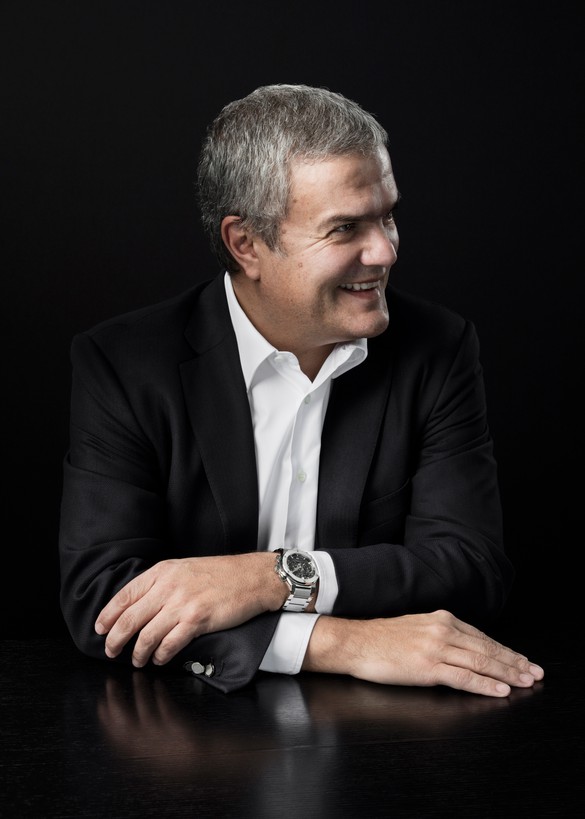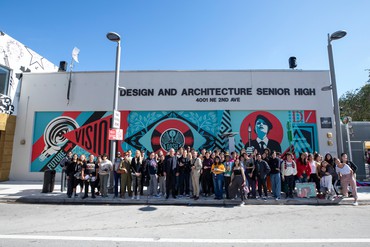Gagosian QuarterlyWhat role does fine art play in the approach to Hublot? Are there particular artists, museums, or art movements that inspire the Hublot aesthetic?
Ricardo GuadalupeAt Hublot, we make watches, which is an art in and of itself that has existed for a few centuries now. But we believe that we must find new sources of inspiration and new platforms of communication to new audiences. I will mention two partnerships that are very successful at the moment. We are collaborating with Sang Bleu, a tattoo studio with locations in London, Zurich, and Los Angeles. Its founder, Maxime Plescia-Büchi, is a famous tattoo artist and we have been inspired by his art, and have incorporated his graphics into a watch. We are also working with the sculptor Richard Orlinski. We have taken inspiration from the facets of his sculptures and inserted that into another watch. Our watches are a fusion between the watchmaking art and the art of a particular artist. I think it’s a new way of creating, of making a new type of watch that becomes a piece of art itself. This is something we have explored over the last four or five years and that we want to explore further through collaborations with other artists as well.
gqHow did the Hublot Loves Art campaign, whose creation you oversaw, come to be?
RGIt started with Art Basel Miami. We have been working with artists and doing events there for many years now. We did something with Mr. Brainwash. We did something with Hebru Brantley. We recently worked with Shepard Fairey. Seeing the art they were creating, the idea came to one day put this art into a watch. But it’s not easy to take a picture and put it in a watch. It’s easier when the art is three-dimensional, like a sculpture, or graphic, like a tattoo.
GQYour mention of Art Basel in Miami makes us think about how we’re all missing it this year. We would love to hear what some of your favorite memories of Art Basel Miami in the past have been.
RGWe did a project with Carlos Cruz-Diez, a Venezuelan kinetic artist who died, unfortunately, last year. He was quite close to a hundred years old. I remember the moments of coming together and celebrating and having fun—for instance, listening to the reggaeton musician Nicky Jam.
GQYou’ve also collaborated and partnered with a number of musicians and sports figures. Do those follow a similar process of collaboration?
RGOf course, there is always room for inspiration. Some mediums—such as music, for instance—are more difficult to interpret within a watch than others, as I said. But the approach is always in partnership.
We partnered with Depeche Mode, for example, sponsoring two of their world tours and creating a limited-edition watch. The idea behind collaborating with bands or singers is to be able to touch a new population with each musical partnership. But, of course, sports remain our main realm of partnership.
GQ We’d love to hear more about the process behind the design and the creation of these watches. These pieces are so intricate. What is your artisan studio like? Do they create sketches and then source materials? How does the process unfold?
RGIt depends on the partnership. In the case of Sang Bleu, Maxime is passionate about watches. He made a lot of sketches which he then left with us to interpret and translate into a watch. The challenge of making a watch is that it’s a small product—maybe 4 cm wide and 1 cm thick—so we have to be able to interpret the art on a small, three-dimensional scale. The artist works closely with our team of creators and designers. We begin with the artist’s vision and our team adds our own ideas—and the end result has been quite amazing.
GQCould you tell us a little bit about the history of the brand?
RGWe’re a young brand, forty years old this year. Normally the traditional luxury watch brands have two or three hundred years of history. But at Hublot, we have created something different in the watchmaking industry. In 1980, when we first started making watches, putting rubber in the strap, together with an 18-karat gold watch, was unheard of. Gold is an ancient material and rubber is a modern material; when you combine modern with traditional, that’s what we call the art of fusion. Before, a watch was made of gold or, in the past fifty years, of steel. We brought in ceramics. We invented magic gold, which is a new 18-karat unscratchable gold. We were the first brand to use a translucent sapphire crystal material. And we tried to reinvent the mechanics of the watch’s movement, to make watches that are really connected to the future and not just repeating the past.
Photos: courtesy Hublot














